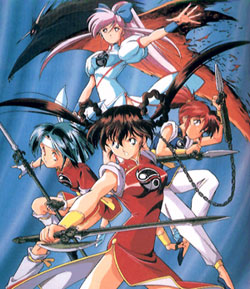
Matt
Greenfield
Interview by Chuck Shandry
Matt Greenfield
has worn a lot of hats in his years with ADV Films: Voice actor (as Brian
Granveildt), director, writer, producer, and, by the way, co-founder of
ADV films. As Japanese animation, or anime, has gone from a fringe novelty
in the U.S. to a mainstream-24/7 network, Matt has seen it all. And he
still attends conventions.
Matt Greenfield, co-founder and V-P of ADV Films kindly agreed to this interview via e-mail.
First
off, let me say it's a pleasure to conduct this interview. My first question:
What was the first anime you remember, knowing it was Japanese animation?
Wow. It was a LONG time ago, sometime in the early seventies… 1971 or '72, I think. I was watching either Kimba or Astroboy, and my dad made a comment about the same artist having drawn both series. I don't think he actually knew Tezuka's name, but he did know that he was Japanese. Now, the first time I ever watched anime in the raw Japanese would have been a bit later, maybe 1983.
I have, over the years, bought Devil Hunter Yohko three times (subbed VHS, dubbed VHS, and the DVD collection). What enticed you to make this your first release?
Well, when I met John Ledford and we started ADV in 1992, I'd already been thinking about how anime was really getting pigeon-holed with the whole "it's all about giant robots" stereotype when there was so much else available out there. John had been thinking in the same vein and for a maverick young company to make a name for itself, we knew we had to do something that would make people take notice. We had both made up lists of titles that we thought would be solid sellers and Devil Hunter Yohko was on both our lists, as were Burn Up! and the original Sol Bianca. Since Toho, the producers of Yohko, actually had an American licensing branch, and since Yohko was both a bit on the racy side and also hysterically funny, we thought it would be an ideal choice for making ADV stand out from the crowd.
What are
the three main criteria for trying to acquire a distribution license?
And try to walk us through how a show is brought over to the States.
It's changed since we started, but essentially you're making an agreement to take someone else's product and sell it in a market that the original producer couldn't effectively market it in themselves. When ADV started all it took was a sizable down payment, because to the Japanese it was like "found" money. A lot of the companies couldn't believe that we really wanted to buy the rights to these things. Now, of course, that the market has been built up so much and the expectations for each new title are so high that the Japanese companies are going to want some kind of proof that you're going to make them more money than anyone else could. So, in addition to a financial commitment, it becomes a matter of your track records and your established relationships with the licensor and other companies. Once you've made a deal, it's all pretty much automatic in that masters, scripts, etc., get sent from the licensor and you convert those into something that consumers can buy or rent. Most other companies farm this out to different outside vendors, but at ADV we do all of this in house, translating, subtitling, dubbing, DVD authoring and designing the packaging. Not only does it help make things run a little faster, but if anyone has any questions about something someone else did, all they have to do is walk down the hallway and ask.
What are
your views on the future of anime? Is there the possibility of over-saturation?
Oh, I think it's nowhere near as big as it's going to get. However, in the long run I think that what's going to happen is that so many young creators in this country (and around the world, for that matter,) are going to be so inspired by the anime they're watching now, that within the next ten years you'll see a real blurring of the differences between animation produced in Japan and animation produced elsewhere. For the last thirty years there was a sort of artificial constraint put around what you could and couldn't do in animation in North America, the kind of stories you could tell and what you could visually show, but the success of anime has finally demolished those barriers.